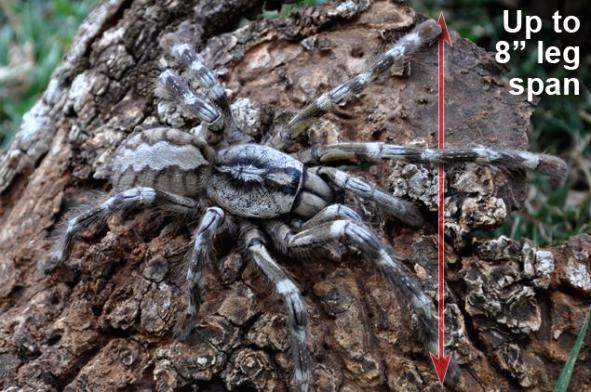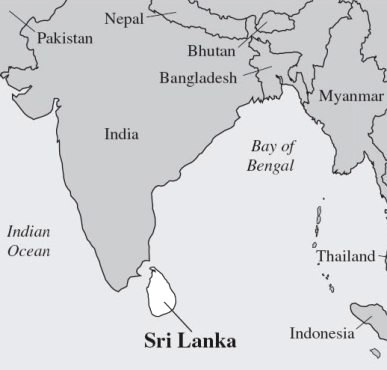

New Species of Tarantula Found in Sri Lanka:
It's the size of a human face
IN THE ARCHIVES:
Meteorites
Coffin Therapy
Strange Street Signs
Catfish Hunt on Land
Apocalypse
CPR Zombies
History of Halloween
Modern Case of Plague
The newly discovered Poecilotheria rajaei tarantula

Yahoo News (April 4, 2013) -- A large species of tarantula, roughly the size of an adult human face, has been discovered in Sri Lanka.
And while the venom of the Poecilotheria rajaei is not lethal to humans, there’s little doubt the abnormal size of the spider could be disturbing, even to those not afflicted with arachnophobia.
The spider’s leg span is a reported 8 inches, with researchers comparing its circumference with the size of a dinner plate. It's covered in a variety of colors, including pink, yellow and gray.
The tarantula was officially discovered by the British Tarantula Society, proving simultaneously that there are still wondrous creatures waiting to be discovered in the wild and at least one official society dedicated to tarantulas.
"It can be quite attractive, unless spiders freak you out," said Peter Kirk, editor of the British Tarantula Society journal, in an interview with the New York Daily News.
“I absolutely would love to see DNA sampling done—on all the species of Poecilotheria,” he said in a separate interview with Wired.
Another observation sure to prove unsettling for those not comfortable with the idea of spiders the size of dinner plates is that they have taken to living inside human dwellings.
Ramil Nanayakkara, co-founder of Sri Lanka’s Biodiversity Education and Research, told Wired, "They prefer well-established old trees, but due to deforestation the number have dwindled, and due to lack of suitable habitat they enter old buildings."
The tarantula was technically first uncovered in 2009, when a local villager brought the body of a deceased rajaei to Nanayakkara. But because Sri Lanka is currently undergoing a dangerous civil war, he was forced to recruit a police officer to assist him and his team as they conducted a search of the island nation’s forests for living specimens.
See the entire article HERE

WHERE IS SRI LANKA?

Sri Lanka is an island country in the northern Indian Ocean off the southern coast of the Indian subcontinent in South Asia. Known until 1972 as Ceylon, Sri Lanka has maritime borders with India to the northwest and the Maldives to the southwest.
An important producer of tea, coffee, gemstones, coconuts, rubber and the native cinnamon, Sri Lanka has been called The Tear Drop of India because of its shape and location and is known as "The Pearl of the Indian Ocean" because of its natural beauty. It is also known as "The nation of smiling people". The island contains tropical forests, and diverse landscapes with high biodiversity.
See more about Sri Lanka HERE
SHOULD WE BE AFRAID OF TARANTULAS?

No, for the most part, we should not be afraid. I personally have held a tarantula in my hand and it felt light and a bit ticklish, but it made no aggressive moves and did not bite. However, it would probably be best to talk to an expert about a species before handling it as there are many different types of tarantulas.
Tarantulas give some people the creeps because of their large, hairy bodies and legs. But these spiders are harmless to humans (except for a painful bite), and their mild venom is weaker than a typical bee's. Among arachnid enthusiasts, these spiders have become popular pets.
There are hundreds of tarantula species found in most of the world's tropical, subtropical, and arid regions. They vary in color and behavior according to their specific environments. Generally, however, tarantulas are burrowers that live in the ground.
Tarantulas are slow and deliberate movers, but accomplished nocturnal predators. Insects are their main prey, but they also target bigger game, including frogs, toads, and mice. The South American bird-eating spider, as it name suggests, is even able to prey upon small birds.
A tarantula doesn't use a web to ensnare prey, though it may spin a trip wire to signal an alert when something approaches its burrow. These spiders grab with their appendages, inject paralyzing venom, and dispatch their unfortunate victims with their fangs. They also secrete digestive enzymes to liquefy their victims' bodies so that they can suck them up through their straw-like mouth openings. After a large meal, the tarantula may not need to eat for a month.
Tarantulas have few natural enemies, but parasitic pepsis wasps are a formidable exception. Such a wasp will paralyze a tarantula with its sting and lay its eggs on the spider's body. When the eggs hatch, wasp larvae gorge themselves on the still living tarantula.
Read more about tarantulas HERE